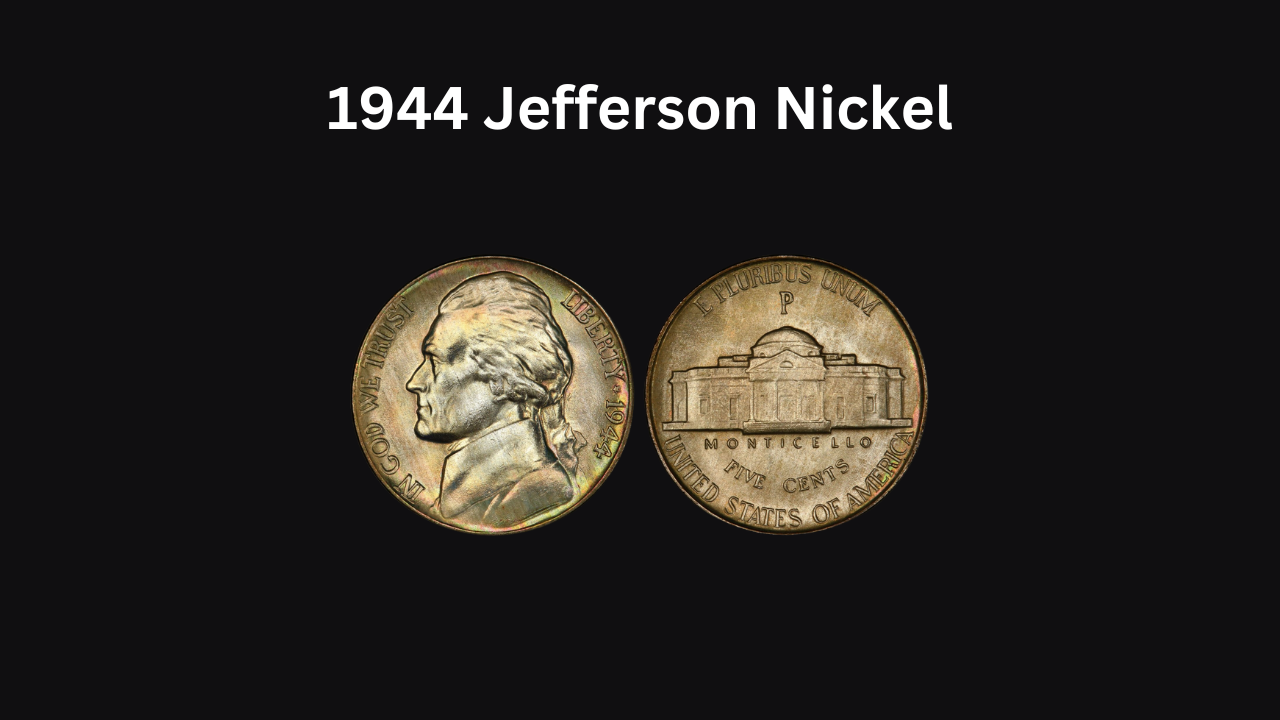The 1944 Jefferson Nickel holds a unique place in American coinage history. Minted during World War II, this coin reflects the economic adjustments of the time and remains a favorite among collectors.
Let’s explore its background, varieties, and value.
What Makes the 1944 Jefferson Nickel Unique?
The Jefferson Nickel replaced the Buffalo Nickel in 1938 due to difficulties in minting the latter. Designed by Felix Schlag, the nickel featured Founding Father and third U.S. President, Thomas Jefferson, on its obverse, with his Monticello home on the reverse.
During the war, nickel—a critical material for military equipment—was conserved, leading to the creation of “War Nickels” (1942-1945). These coins were composed of 56% copper, 35% silver, and 9% manganese. This makes the 1944 Jefferson Nickel stand out with its unique silver content.
Key Features of the 1944 Jefferson Nickel
- Obverse: A left-facing portrait of Thomas Jefferson with inscriptions “IN GOD WE TRUST,” “LIBERTY,” and the year “1944.”
- Reverse: Monticello, Jefferson’s historic home, along with “E PLURIBUS UNUM,” “UNITED STATES OF AMERICA,” and “FIVE CENTS.” The mintmark appears prominently above Monticello’s dome.
Varieties of the 1944 Jefferson Nickel
The U.S. Mint produced three distinct varieties in 1944, named after their mint locations: Philadelphia (P), Denver (D), and San Francisco (S). Each variety has unique features and mintages.
1944-P Jefferson Nickel

- Mintage: 119,150,000
- Features: Marked with a large “P” above Monticello.
- Value Range: $2.50 to $25, depending on condition. Rare MS67 coins can fetch significantly higher prices.
1944-D Jefferson Nickel

- Mintage: 32,309,000
- Features: Marked with a “D” mintmark.
- Value Range: $8 to $750, with top-graded coins valued at thousands.
1944-S Jefferson Nickel

- Mintage: 21,640,000 (second lowest of the series)
- Features: Marked with an “S” mintmark.
- Value Range: $1.64 to $23, with high-grade coins commanding a premium.
Famous Errors and Variations
With over 463 million nickels minted in 1944, some errors naturally occurred. These mistakes often increase the coin’s value among collectors:
- Doubled Die Errors: Coins struck with a die engraved at two slightly different angles. Values range from $25 to $100 or more.
- Repunched Mintmarks: Mintmarks are punched multiple times or misaligned. Prices start at $3 and can go up to $100 for rarer examples.
- Off-Center Strikes: Part of the coin’s design is missing due to misalignment. Values range from $5 to $100, depending on the extent of the error.
1939 Liberty Half Dollar: A Silver Treasure in Your Pocket?
Counterfeit Alert: Henning Nickels
Francis LeRoy Henning counterfeited Jefferson’s nickels in the mid-20th century, including the 1944 version. These “Henning nickels” lacked the prominent mintmark and often had noticeable flaws.
Despite their history, these counterfeits are generally affordable, with high-grade examples priced under $100.
Determining the Value of a 1944 Jefferson Nickel
The value of a 1944 Jefferson Nickel depends on its condition, mintmark, and rarity. Coins graded as Mint State (MS) are especially valuable. Here’s a brief guide:
- Good (G-4): $0.10
- Fine (F-12): $1
- Extremely Fine (XF-40): $2.50
- Uncirculated (MS-60): $3-$22
- Superb Gem Uncirculated (MS-67): $69-$1,645 or more
Notably, auction records show exceptional sales:
- A 1944-D MS68 sold for $22,325.
- A 1944-S MS68 fetched $14,100.
Discovering the 1941 Mercury Dime Proof: A Collector’s Dream!
Where to Buy or Sell a 1944 Jefferson Nickel?
Collectors can buy or sell 1944 Jefferson Nickels through various platforms:
- Online Marketplaces: Websites like eBay and Amazon offer a wide range of options. However, beware of counterfeit listings and always verify sellers.
- Specialized Coin Dealers: Trusted dealers provide authenticity guarantees and expert evaluations.
- Auctions and Coin Shows: Ideal for finding rare or high-grade examples.
- Local Shops: Pawnshops, antique stores, and coin shops are good alternatives for face-to-face transactions.
Editorial Note: This article was created through automated technology, with all details verified and polished by our editorial expert..

